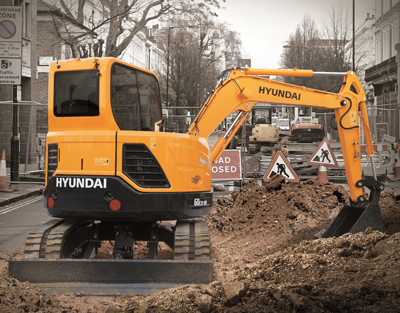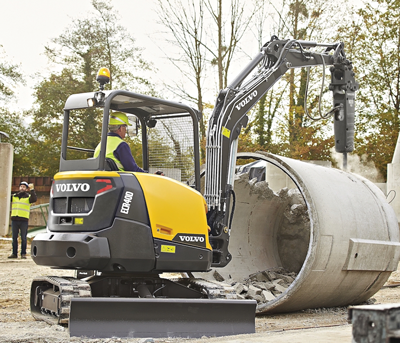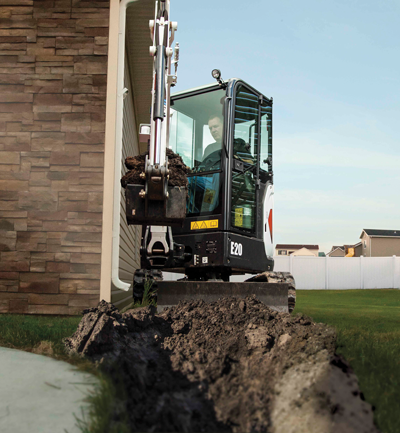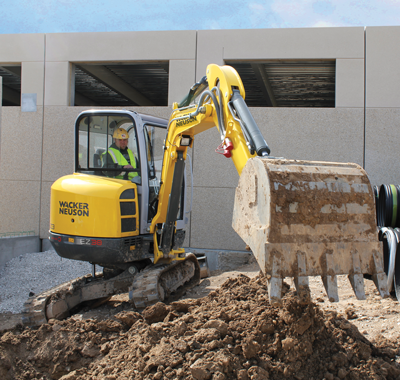Industry outlook: Mini excavators tread new rental territory
Attachments, power options and versatile operator settings increase rentability

Tracked compact or mini excavators, which the Association of Equipment Manufacturers define as 0 to 6 metric tons, can get into tight places.
Most units can be hauled from yard to job site with Class 1 and Class 2 trucks. Usually, that means the driver isn’t required to have a Commercial Driver’s License (depending on the local regulations).
The AEM reports the 3- to 4-metric ton units are the most popular. These models are extremely versatile, performing in-building work, tight subdivision sewer repairs, water line installation and foundation repairs. They save countless hours of labor compared with doing excavation work by hand.
Pro Contractor Rentals magazine asked leading mini excavator manufacturers on how and why rental centers are adding mini excavators to their rental fleets.
Their insights share helpful selection information and features that can expand their versatility – and rentability.
 |
Juston Thompson, Product Training Manager, Hyundai Construction Equipment Americas
Hyundai’s new 9A series compact excavators feature Hyundai quick couplers for easy switching between attachments, enabling operators to take on a variety of jobs. The quick coupler is standard on all 9A series models except the smallest unit, the R17Z-9A; auxiliary hydraulic piping also is standard, accommodating a variety of attachments.
A standard pattern-change valve, positioned for easy access, changes joystick control from SAE to ISO operation, depending on operator preference. This is especially useful for rentals where a different operator may be in the cab every day.
The 9A line of mini excavators features an innovative, precision hydraulic system that provides fast, smooth and easy control. Hyundai redesigned the hydraulic system on the three largest 9A series models to provide the operator with super-fine touch and improved control, which enhances operating precision. The arm flow summation system combines flow from both pumps, which reduces cavitation and increases arm speed.
The standard boom swing function allows the boom to offset 75 degrees to the left and 50 degrees to the right for efficient work in congested areas. Other standard features include factory-installed thumb brackets and large dozer blades.
Enhanced reliability features include bushings with longer lubrication intervals and integrated preheating systems that extend service intervals and reduce machine downtime.
The canopy-style frame on the 9A models assure operator safety and comply with international operator protection standards. The models also feature foldable pedals for
added cab space; in-cab storage compartments are popular with
operators.
Controls are located for improved operator comfort and productivity. The LCD cluster display in the three larger models monitors seven warning indicators, water temperature, fuel level and operating hours. The operator experience is enhanced with a fully adjustable suspension seat, wrist rests, ergonomically designed joysticks and plenty of legroom.
Hyundai’s 9A series includes six compact excavator models, including three zero-tail swing models, two compact-radius models and one with standard counterweight configuration.
The 6-ton Hyundai R60CR-9A is a popular choice among rental centers. It is a compact-radius model powered by a Tier 4 Final-certified Yanmar engine with net 63 hp. Bucket breakout force is 8,220 ft.-lbs. and maximum dig depth is 11 feet 9 inches. Its standard auto-idle function reduces engine speed automatically when operators are not using the controls.
Hyundai excavators are compatible with a full spectrum of third-party attachments, as well as Hyundai hydraulic breakers.
 |
John Comrie, Product Manager, Volvo Construction Equipment
Attachments improve rentability
The growing number of applications for compact excavators makes them appealing from a rental and a purchase standpoint. However, the rental market captures nearly 60 percent of compact excavator business. Customers appreciate that renting protects them from a machine sitting idle during slow times.
Roles for compact excavators have been expanding in recent years with contractors realizing the wide range of versatility the machines offer, especially with the multitude of attachments now available. While skid steers and compact track loaders have historically been viewed as the Swiss Army Knife of the industry, compact excavators are earning a place among those ranks.
 |
| In addition to the benefits contractors are seeing through the versatility of compact excavators, rental companies are also experiencing the nice return on investment from a machine that’s staying off the rental lot. |
The compact excavator is following in the footsteps of the skid steer. The versatility of compact excavators is leading to its increasing presence on job sites. The growing presence of compact excavators on job sites is due in part to popular attachments, which include the angle blade for backfilling trenches, saws, augers, hammers and many styles of buckets.
These attachments, paired with the maneuverability of the machines, are making compact excavators a perfect match for multiple applications: moving material to assist with new residential construction sites, prepping foundations for site work, helping dig trenches for cable and water lines and installing or repairing utilities. This list of applications has continued to grow.
Where customers would have used a rubber-tire backhoe in past, many are discovering the compact excavator is a good alternative. Renting allows the rental center to customize the machine in a more cost-effective way for customers. Rental companies do a fantastic job of asking customers the right questions upfront so they can get the customer set with the right machine size and attachments to get their job done in the most efficient way possible. Renting offers the flexibility to change attachments and even machine size to best match the job without being locked into one machine.
Mini excavators often use the same control patterns as larger machines. Training is often an afterthought, but because compact excavators use the same joystick configurations as their larger counterparts, operators can easily swap seats from a large excavator to a compact one without losing efficiency.
In addition to the benefits contractors are seeing through the versatility of compact excavators, rental companies are also experiencing the nice return on investment from a machine that’s staying off the rental lot. The machine’s relatively small size makes it easy to transport between customers.
As rental companies work with customers, they are finding diverse customer needs: some are more focused on performance, while others are focused on compact size. Volvo has models to suit both types, such as the EC35D, a 7,500- to 8,000-pound machine, which
comprises the biggest segment of the industry, and the ECR40D, an 8,500- to 9,800-pound short-radius machine.
Volvo’s 2.5-ton EC25D and conventional EC20D are joined by the 6-ton EC60E, with a cab that is 20 percent larger than past models, making it the largest in the industry. Volvo compact excavators are designed with the same dedication to detail as large Volvo excavators: They all have quiet, and big, roomy cabs for ample leg room and storage.
New Volvo excavators can get more done with less horsepower. Volvo engineers have been able to considerably lower horsepower without sacrificing machine performance. The Volvo EC35D and ECR40D mini excavators have reduced horsepower requirements from 36 to 24 while increasing performance in lift capacity and breakout/tear-out force. Their unique hydraulic regeneration system means the pump doesn’t have to work as hard to maintain the required oil flow, so it requires less engine horsepower.
 |
Ed Brenton, Brand Marketing Manager, Case Construction Equipment
Compact excavators placed into the rental market are often, but not always, basic machines without a full cab or many of the amenities that an owner/operator may specify. Many of the bells and whistles offered by manufacturers simply add to a rental business’ overhead and reduce the profitability of the machine – and offering fewer options ultimately allows for simpler operation by rental customers who may not be as familiar with operating that machine.
When features are added to compact excavators in the rental market, they typically add a direct and practical benefit that makes it more attractive to potential renters or to the rental company. This includes SiteWatch telematics on Case equipment that can track a unit’s location and maintenance intervals; or hydraulic or mechanical quick couplers for easier bucket and attachment changes; and thumbs that allow for better material placement and added versatility.
Look at each machine as a platform that gives the operator the ability to perform a certain kind of job. The more application versatility rental suppliers can offer their customers through their available machines, the more satisfied that cusomter will be and more likely to return.
Specialty attachments – such as tilting or rotating couplers and tilting buckets – may require a secondary hydraulic circuit for proper operation. Having a model or two outfitted with a hydraulic thumb could be very beneficial to rental customers as it gives them an excellent tool for grabbing loose debris or materials.
The type of track is also going to be important to the renter. Having steel- and rubber-tracked machines can help assure the rental center has the best machine for the customer’s needs. Rubber-tracked machines disturb the soil or improved surfaces less, while a steel track provides more bite and traction into the soil.
 |
Nathan Ryan,Product Manager, Gehl, Manitou Americas
Compact excavator sales into the rental segment has declined recently as the North American economic recovery progressed. As contractors and small business owners saw the number of housing starts grow and commercial construction projects gain funding approval, they regained confidence in making equipment investments.
Despite this recent slump, rental continues to be the largest segment of the market for compact excavators. This is driven by the fact that when an excavator is needed, there is no substitute for this critical tool.
Ultization rates drive the rent vs. buy mini-excavator decision. Historical figures reveal that about one third of the industry has decided rental is the best option and it’s unlikely that will change in the near future.
The most beneficial feature is a rental excavator can be equipped with a hydraulic quick coupler, ideally a pin-grabbing style coupler. The quick coupler allows the rental company to offer a variety of bucket widths as well as other productivity-enhancing attachments without the downtime need to install the renter’s requested attachments.
Contractors and operators renting excavators with quick couplers benefit from using the correct size bucket for the job at hand and significantly reduced attachment-changeover time. Pin-grabbing couplers add the possibility for attachment interchangeability for contractors with a mix of rental units and their own compact excavator fleet.
 |
Jordan Dey, Compact Excavator Product Specialist, JCB
The compact excavator market has grown significantly in the past five years. Sales are increasing year over year and market growth continues to trend in compact equipment. The rental market, as of the end of October 2016, is up 4.4 percent and the market as a whole is up 11.8 percent.
JCB compact excavators offer a number of features designed to help rental centers and their customers get more from their machines. One example is a 500-hour digging grease interval that reduces required maintenance and keeps the machine out on the job for longer periods of time.
Tier 4 Final-compliant engines that do not need a diesel particulate filter (DPF) also contribute to this focus on less maintenance. The larger models feature a 30-degree tilting cab that makes it easy to access the machine’s components. These features greatly affect machine acquisition cost, durability and maintenance.
These features help rental centers quickly turn around machines and get them back out on the next rental for a better return on investment. They also assure that customers can use the machine without interruption for DPF regeneration. For a rental center, this combination provides a low-maintenance, structurally-sound machine with higher residual values.
Rental centers may be dealing with end users who aren’t as familiar with compact excavator operation, so safety features needs to be built into the machine. For example, JCB compact excavators feature a 100 percent pressed-steel body for a strong, solid upper structure. This reduces the likelihood that expected wear-and-tear common in rental applications would cause substantial damage to the machine. It also protects the components under the hood. This combination provides a low-maintenance, structurally sound machine with high residual value. The end user gets a strong, robust machine with easy access to key checks and helps protect rental centers from operators who may damage the machine.
Conventional tail-swing models provide a higher breakout force, while zero tail-swing models are better for constrained areas. JCB offers 11 models that cover conventional and zero-tail-swing needs within each weight category, providing the right machine for any application.
The JCB models allow auxiliary hydraulic flows to be programmed for precise and versatile operation of attachments. The pin geometry and JCB hydraulic quick coupler can be outfitted with a wide range of bucket pin centers, making it compatible with a rental center’s existing fleet of attachments from most excavator manufacturers in each weight class.
 |
Tom Connor, Excavator Product Specialist, Bobcat Company
Compact excavators a smart choice for rental customers
Following a dip during the Great Recession, there has been a gradual increase of compact excavator sales in the United States, particularly in the 3 metric ton size class. Recent data shows more customers are purchasing compact excavators than tractor loader backhoes for excavating, trenching and grading applications.
For customers concerned with purchasing equipment, rental is an efficient way for them to add to their existing fleet and help them grow their business. Renting compact equipment can shift the burden of ownership costs such as insurance and scheduled maintenance. This can be attractive to contractors who are not ready to purchase but have immediate equipment needs. Transporting compact excavators can be less expensive than larger construction equipment that requires a bigger trailer and potentially, special permits in some areas.
 |
|
Recent data shows more customers are purchasing compact excavators than tractor loader backhoes for excavating, trenching and grading applications. |
Bobcat Company continues to refine its compact excavators with improvements in performance, operator comfort, ease of maintenance, versatility and fuel efficiency.
For example, the Eco Mode setting on a Bobcat excavator can save as much as eight percent in fuel. If the excavator is equipped with an optional deluxe instrument panel, the operator has access to Eco-Mode settings, plus fuel consumption data, multilingual functionality, keyless-start system and detailed engine and hydraulic system information. The forward-mount instrument panel makes it easy for operators to quickly glance at the LCD screen.
For rental customers who need additional dig depth, reach and dump height without moving up to a bigger excavator or a tractor loader backhoe, the Bobcat extendable-arm option is a smart choice. Operators can hydraulically extend the arm up to 30 inches to help minimize repositioning the machine. Bobcat is the only compact excavator manufacturer to offer a hydraulic clamp-ready extendable-arm option.
Bobcat offers rental centers three tail-swing types — conventional, minimal and zero — to help them and their customers best match the job site conditions. A conventional tail swing provides a balance of tail swing and rotation to optimize lifting stability. A minimal tail swing offers a tight tail swing with impressive lifting capabilities. Zero-tail-swing excavators offer unrestricted rotation and ultimate flexibility for working close to walls or other obstacles. For further versatility, Bobcat excavators are designed with an in-track swing frame to allow for digging flush against an obstacle for precise movements and reduced machine repositioning.
Attachments have played an important role in the growing use of compact excavators in construction and rental applications. Rental centers may choose from 17 approved attachments to expand their Bobcat compact excavator’s versatility. Customers
can easily change attachments with Bobcat’s X-Change attachment mounting system.
For even faster changes, a hydraulic X-Change mounting system is available for select models. Customers who can easily change attachments are more likely to use the proper bucket size for the application, which requires less backfilling or re-work and improved productivity. Plus, if attachments are easy to change, rental customers are more likely to rent additional equipment attachments.
For more precise control of select Bobcat attachments, Bobcat Company offers selectable auxiliary hydraulic flow. Operators can choose from three auxiliary hydraulic flow settings on the instrument panel to best match the application. Low flow is best for use with excavator attachment tilt accessories for more accurate angles in trenches; medium flow is well suited for use with hydraulic clamps and grapples when placing boulders or handling other bulky material; and maximum flow is ideal for use with hydraulic breakers or augers for peak attachment performance.
Rental centers want an excavator that is easy to maintain so they can keep the machine running with more uptime and rental potential. When evaluating compact excavators, look for a compact excavator that has easy, convenient access to all daily checkpoints, such as vital machine fluids and other important maintenance items. Also check to see if the machine has centralized grease points for the slew bearing and pinion gear.
Attachments multiply the versatility of compact excavators and Bobcat Company recently added the Pro Clamp system to its attachment line. It is adjustable to allow operators to grab larger, more irregular-shaped material than a standard hydraulic clamp. It can also be used to grade trench bottoms efficiently.
The new flail mower attachment appeals to a variety of rental customers. Available in three sizes, they can be used to clear ditches, hillsides, utility right-of-ways and riverbanks. Bobcat flail mower attachments are capable of mulching tree branches and saplings up to four inches in diameter.
 |
George Lumpkins, Product Training Manager/
National Service Manager, Kobelco USA
Fuel-saving, full-featured performance
Kobelco mini excavators offer maximum efficiency on the job. These mini models utilize ground-breaking energy conservation elements, including S-mode, which enables users to reduce the machine’s fuel consumption by 25 percent. A one-touch deceleration button allows for easy switching to idle mode, significantly reducing fuel consumption while the machine is at rest.
Kobelco showcases its revolutionary Integrated Noise and Dust Reduction Cooling System with Eco-friendly features (iNDr+E) cooling system on select mini excavator models.
Kobelco mini excavator models pack full-size performance into a portable package for easy transportability. A minimal rear-swing radius with zero-tail overhang offers excellent handling in confined spaces while a simple design makes routine maintenance easy.
Kobelco mini excavators come with a blade as standard equipment for backfilling and dozing; select models feature the new Kobelco four-way blade option that delivers a left and right angle movement of 23 to 25 degrees for increased operator control for clearing, grading and backfilling.
Kobelco mini excavators supply ample muscle for heavy-duty digging and lifting and are excellent for loading, placing and dozing in various applications. A large boom and arm provides a wide working range, while a short tail swing improves operating efficiency in a tight space. A minimal rear swing radius, zero tail overhang and excellent side-ditch digging performance provides safe and easy operation. That helps operators concentrate on the work in front of them for greater efficiency. A standard pattern changer allows for increased utilization and flexibility to match operator preference on the job.
The Kobelco mini excavators are ideal for small landscape and construction jobs as well as utility work.
Michael Shebetka, Product Manager, Takeuchi-US
Dual-power units improve versatility
Over the years, Takeuchi equipment has gained a reputation for its durability and performance. While cabin design and engine after-treatment systems have evolved over time, Takeuchi has stuck to its roots by manufacturing machines that feature pilot controls that are exceptionally durable, simple and responsive. They feature all-steel construction and are built to provide years of trouble-free service and higher resale value.
The Takeuchi Fleet Management (TFM) telematics system is standard on a majority of Takeuchi excavators and compact track loaders. It benefits end users and rental companies seeking to keep operating cost and downtime to a minimum. The telematics system allows customers to monitor the machine’s overall health and performance, be more proactive on scheduled maintenance and have the ability to track the unit’s location.
Takeuchi recently released a 4,200-pound dual-power TB216H diesel/plug-in electric hybrid excavator with a hydraulically adjustable track frame. This is a nice addition to the Takeuchi product line that will be attractive to rental fleets and contractors working in enclosed structures that require zero emissions.
The TB216H performs as well as the diesel-powered TB216 mini-excavator. The diesel engine is rated at 14.9 hp. and the electric motor is rated at 14.2 hp. and each features its own set of hydraulic pumps with identical displacement. Standard auxiliary hydraulics allow this unit to be a versatile attachment platform for indoor and outdoor jobs.
The Takeuchi TB260, TB280FR, TB290, and TB2150 feature three track options: steel, rubber and segmented rubber. Each track system has unique advantages. Rubber track is a good all-around track system that can be used on hard and soft surfaces and creates low vibration and noise; segmented rubber track features a harder rubber compound and steel reinforcements within the pad is ideal for hard and soft surfaces and allows individual pad replacement; and steel track is ideal for soft surfaces and demolition while providing long life and good flotation characteristics.
Jeff Jacobsmeyer, Product Manager, Kubota
Simple operation required
Rental customers appreciate simple, easy-to-operate machines. Rental customers often do not operate these types of machines daily or even on a weekly basis; a large percentage of compact machines are rented for specific short-term projects. That makes consistency of controls and cab ergonomics important.
The controls and dash settings for a Kubota 3- or 4-ton machine operate like the Kubota 8-ton excavator, which makes learning and transition into the smaller machine minimal. Auxiliary flow control for attachments is a very important option to renters. Kubota models have an in-cab adjustment that can vary the flow to the attachment. For example, a hydraulic thumb needs a lower flow to operate precisely, where a hydraulic breaker or
hammer needs maximum flow. These settings are made in the cab, tool-free.
A manual quick coupler makes it easy to switch between attachments. Simply pull the coupler pin and maneuver the coupler to the next attachment and reinstall the pin for a quick change of attachments. Buckets, augers, mowers, breakers, can all be switched quickly for different applications.
 |
|
Wacker Neuson’s Vertical Dig System allows users to level the cab and bucket on an uneven surface. |
Warren Anderson, Product Manager, Excavators and Dumpers, Wacker Neuson
Mini excavators are evolving and many features are becoming preferred by end-user customers. Auto-idle, ISO/SAE pattern changeover, Vertical Digging System (VDS) and angle blades are being increasingly requested by rental customers.
Auto idle saves on fuel use and reduces noise while users answer a call or talk with a colleague. The ISO/SAE changeover is not a new feature, but the control has been moved into the cab for easy access.
The Vertical Dig System, a Wacker Neuson-exclusive feature, allows users
to level the cab and bucket on an uneven surface. Rental centers report positive feedback from customers because they no longer need to spend time leveling the work area or excavating more than necessary because of the work angle. Most importantly, VDS helps keep the operator comfortable.
Angle blades are growing in popularity in the rental segment. With an angle blade, users spend less time filling trenches, ultimately saving fuel because fewer passes are needed for trench backfilling.
Wheeled mini excavators allow rental customers to drive the excavator to the work without having to trailer it. This is excellent for work on roadways or in large, open areas where users must dig in several different spots.
New attachments, such as the Rototilt bucket control, allow users to rotate and tilt the bucket or grapple for extremely fine feathering and maneuvering.
Telematics options are becoming more popular for rental fleet managers. It enables them to track units, be alerted to error codes, get accurate hour readings for billing and can be used to geofence equipment, cutting down on unauthorized use.
Wacker Neuson offers an emissions-free option with the 803 Dual Power model. This one-ton excavator can be operated as a standard diesel model or can be attached to a hydraulic power unit (HPU) and operated completely emissions free. The HPU is plugged into an electrical power source to power the unit’s hydraulic system. Rental centers favor this option because they can put the 803 DPU in inventory and rent out the HPU when needed, but the excavator can also be rented and operated as a diesel-powered excavator when reduced emissions are not necessary. The 803 DPU works excellent indoors, where noise levels are a concern and in poorly ventilated areas.









